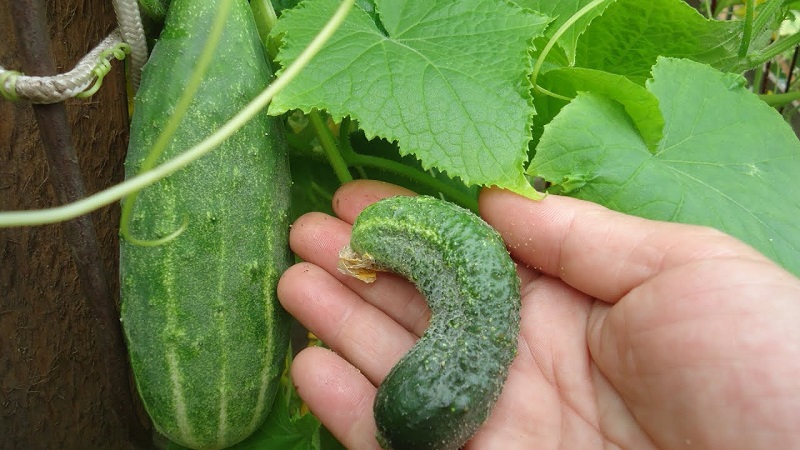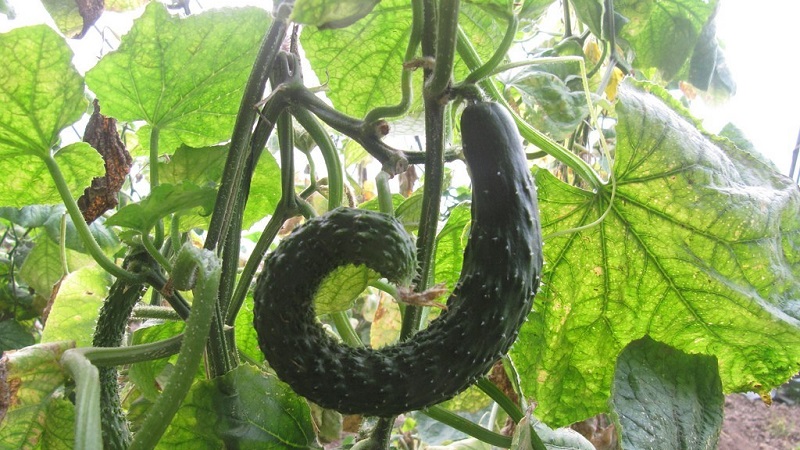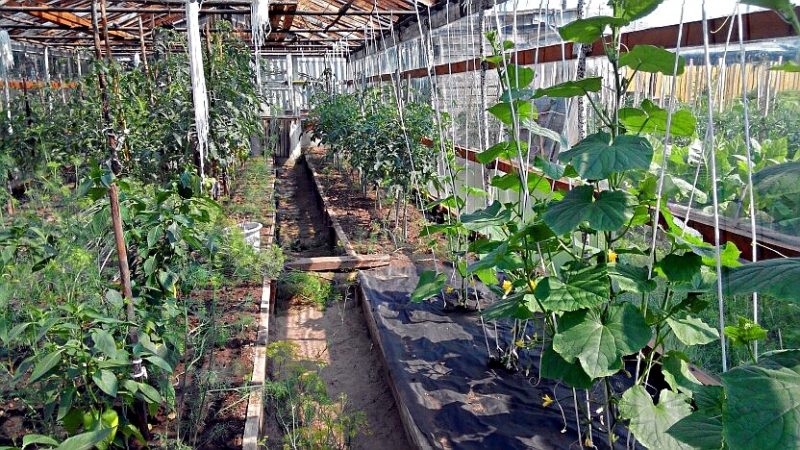Why do cucumbers crochet in a greenhouse and what to do to prevent deformation of the fruit
Cucumbers are among the most popular crops in every vegetable garden. However, when growing this generally unpretentious vegetable in a closed ground, it often happens that the fruits become crooked, lose their presentation and taste.
In the article we will tell you why cucumbers crochet in a greenhouse and how to fix this problem.
The content of the article
Causes of fetal curvature
Deformation of vegetables occurs for various reasons. These can be external factors, agrotechnical violations, inexperience of summer residents. With the timely elimination of errors, the crop can be saved.

Late harvest
If the fruits are not removed from the bushes as they ripen, too many of them are formed, due to which the correct development is disturbed. Crooked cucumbers are not always characterized by a bad taste, but most often housewives refuse to buy such a product on the market, preferring even and beautiful vegetables for preservation.
Too large cucumbers remaining on the bushes are no longer suitable for food, but they still absorb nutrients from the soil. Because of this, young specimens are deficient in micro and macro elements. The optimal frequency of fruit removal is every 2-3 days.
Lack of light and heat
Cucumbers are light-loving crops, sufficient lighting is required for all of their parts - stems, leaves and lower ovaries. If the top grows too much, the foliage blocks the light to the fruits below. Because of this, they can not only deform, but also fall off or completely rot.
Trying to collect as much harvest as possible on the site, many summer residents also make such a mistake - they plant shrubs too densely.
Demanding to climatic conditions is also manifested in air temperature. Cucumbers develop correctly and are saturated at 21-26 ° C, and at night this figure should not fall below 20 ° C. Otherwise, vegetables must be covered, otherwise their growth will stop completely.
Watering irregularities

Improper hydration is one of the most common causes the appearance of deformed specimens. 95% of the fruits are water, so they need regular watering. Development disorders are also manifested due to the use of cold or ice water, this is a great stress on the culture and the reason for the formation of barren flowers.
Important! With a lack of moisture, the plants wither quickly and bear poor fruit, and with an excess, useful substances are washed out of the soil. Experiencing a deficiency of nutrients, the fruits become small, curl and completely rot. In this case, the roots may completely die.
Features of the variety
In some hybrids, curved, hooked fruits are the main characteristic. At the same time, some may have a pronounced deformation, while others - insignificant.
According to the observations of summer residents, the wrong fruits - hook-shaped, pot-bellied or pear-shaped, grow in hybrids:
Curved fruits from Pasadena and Pasamonte account for about 30% of the total crop.
Neighborhood of various varieties

When choosing varieties and hybrids for planting in an open in a greenhouse, carefully study their features, indicated by the manufacturer on the package. Cucumbers can be one of two types.For the formation of ovaries in the first type, pollination is not required, and the latter will bear fruit only with the participation of pollinating insects. Placing these two varieties side by side on the same bed will result in over-pollination, resulting in impaired fruit growth and development.
In addition, an unacceptable neighborhood is the planting of some vegetables. Summer residents have the term "allelopathy"... It means the appearance of specific root and leaf secretions when cucumbers are placed in one greenhouse together with such vegetables:
- tomatoes;
- potatoes;
- spices;
- salad and other greens.
Micronutrient deficiency
The lack of fertilizer leads to various problems. Deformation of the fruit is often caused by potassium deficiency. With potassium starvation, the cucumbers are rounded, at the stalk they become thickened, gradually curl. The fruits die quickly, and those that have been preserved acquire a bitter taste.
Important! Lack of potassium is provoked by top dressing with yeast solution, bird droppings, mullein - these compounds wash out the beneficial trace element.
Top dressing with nitrogen content are important for development at each stage. Its lack negatively affects the formation of green mass, fruiting and flowering, however, an overabundance leads to the appearance of hooked fruits.
Iron deficiency also leads to deformation, which manifests itself initially in leaf discoloration and growth arrest.
How to prevent crocheting cucumbers
To prevent spoilage of the crop, cucumbers need proper care and regular feeding.
Fertilizers
The pledge of even and beautiful cucumbers is feeding with potassium sulfate in combination with other components: 0.5 liters of mullein diluted in 10 liters of water, mix with 0.5 g of potassium sulfate and 0.5 g of boric acid, add 0.3 g of manganese sulfate ...
Fertilizers can be used ready-made, balanced, bought in a store or prepared independently according to folk recipes:
- dilute chicken droppings in an equal proportion with water, insist for 3 days and dilute with water in a ratio of 1:10, inject under the root into the soil;
- Pour 1-2 liters of wood ash with 15 liters of water, stand for 2-3 days and dilute with another 1 bucket of water, pour 0.5 liters of the finished solution under each bush;
- "Kalimagnesia" - 20 g of dry powder per 1 m² at the stage of flowering and during the period of fruit formation.
A rich source of vitamins and minerals - yeast solution. It is rich in nitrogen, phosphorus, manganese, iron, potassium, zinc and potassium. A bucket of water with a volume of 10 liters will require 1 pack of dry product. Insist the composition for a day, to water soil at the rate of 1 liter per 1 bush.
The feeding cycle for cucumbers should consist of at least 5 stages. The first time, potassium and nitrogen are introduced 2 weeks after planting the seedlings, and the second - with the appearance of flowers. The next time fertilizers will be required at the beginning of fruiting, and then after 2-3 weeks. An obligatory element at this stage is phosphorus. In infertile areas, complex formulations can be added 1-2 more times.
Growing conditions and care for cucumbers

To get a rich harvest, follow the rules of agricultural technology. The soil must be constantly loosened, since the resulting crust disrupts air exchange and oxygen access to the roots. The ground is loosened with a hoe before planting seedlings, then they do this very carefully so as not to damage the plants.
Reference. To prevent the formation of an earthen crust, the soil is mulched, covering the surface with sawdust, humus or peat.
Water as needed: in dry and hot weather - 1 time in 2 days, on cloudy and rainy days - pause until the soil is completely dry. Before watering vegetables in the greenhouse, it must be ventilated.
A prerequisite for proper growth is pinching... This is done so that the upper ovaries and leaves do not block the light from the lower parts of the plant, as well as for the even consumption of nutrients by the fruit. The optimal amount is up to 20 ovaries per bush.
Tips from experienced summer residents

Gardeners recommend that you initially carefully consider the conditions of planting, so that later you do not have to take measures to correct errors.
In addition to proper care, it is important:
- observe crop rotation - do not plant cucumbers in the same area for more than 2 years in a row, as well as at the site of growing zucchini, pumpkin, dill;
- choose a suitable variety - self-pollinated should grow in the greenhouse, inseminated in an open area;
- leave enough space when planting - 15-20 cm between the rows of bushes.
The water used for irrigation is preliminarily defended in the sun to warm it up, or diluted with boiling water. For 1 m², 5-8 liters of water is used for young bushes, and for fruiting - 120 liters. Foliar dressing is best done in rainy weather.
Reference. If you cannot follow the rules of crop rotation, you can restore the soil for the next planting using green manure plants. After the autumn harvest, mustard, oats or phacelia are planted on the site. By the end of autumn, the crops will grow up, they can be dug up, and in the spring you can plant cucumbers.
Conclusion
The state of cucumbers must be monitored from the moment the first shoots appear. Proper care, protection from pests and sufficient feeding will allow you to get a high-quality crop of cucumbers of the correct shape in the greenhouse with a large amount of vitamins.